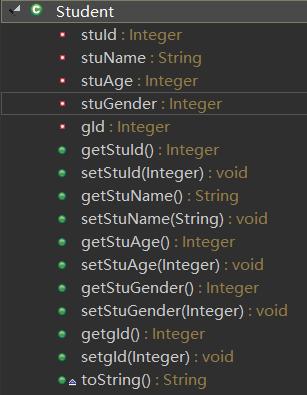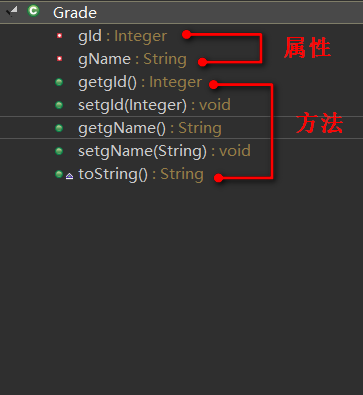SQL映射文件-----MySQL关系映射【1对1,1对多,多对多】
SSM框架下,mapper.xml 中 association 标签和 collection 标签的使用
当数据库中表与表之间有关联时,在对数据库进行操作时,就不只是针对某一张表了,需要联表查询
MyBatis中如何实现联表查询
1、首先新建两张表
学生表(student)
- ID:stu_id
- 姓名:stu_name
- 年龄:stu_age
- 性别:stu_gender
- 所在班级:g_id
班级表(grade)
- ID:g_id
- 班级名称:g_name
学生表和班级表通过 g_id 进行关联,一个班级对应多个学生

2、创建相应的实体类和mapper接口
(1)创建 Student 类和 Grade 类(包名:com.bwlu.bean)


(2)创建 StudentMapper 接口和 GradeMapper 接口和相应的 XML 文件(使用逆向生成可直接生成)
StudentMapper.java 接口
Student selectByPrimaryKey(Integer stuId);//按主键查询一条记录
StudentMapper.xml
<mapper namespace="com.bwlu.mapper.StudentMapper" >
<resultMap id="BaseResultMap" type="com.bwlu.bean.Student" >
<id column="stu_id" property="stuId" jdbcType="INTEGER" />
<result column="stu_name" property="stuName" jdbcType="VARCHAR" />
<result column="stu_age" property="stuAge" jdbcType="INTEGER" />
<result column="stu_gender" property="stuGender" jdbcType="INTEGER" />
<result column="g_id" property="gId" jdbcType="INTEGER" />
</resultMap>
<select id="selectByPrimaryKey" resultMap="BaseResultMap" parameterType="java.lang.Integer" >
select stu_id, stu_name, stu_age, stu_gender, g_id from student
where stu_id = #{stuId,jdbcType=INTEGER}
</select>
</mapper>
GradeMapper.java
Grade selectByPrimaryKey(Integer gId);//按主键查询一条记录
GradeMapper.xml
<mapper namespace="com.bwlu.mapper.GradeMapper" >
<resultMap id="BaseResultMap" type="com.bwlu.bean.Grade" >
<id column="g_id" property="gId" jdbcType="INTEGER" />
<result column="g_name" property="gName" jdbcType="VARCHAR" />
</resultMap>
<select id="selectByPrimaryKey" resultMap="BaseResultMap" parameterType="java.lang.Integer" >
select g_id, g_name from grade
where g_id = #{gId,jdbcType=INTEGER}
</select>
</mapper>
3、在sql映射文件中写映射sql语句【联合查询:级联属性封装结果集】
3.1第一种
(1)在 Student.java 中将 g_id 属性换成班级类型(Grade),并添加相应的getter和setter方法
//private Integer g_id;
private Grade grade;
public Grade getGrade() {
return grade;
}
public void setGrade(Grade grade) {
this.grade = grade;
}
(2)在 xml 中封装结果集,并编写相应的 sql 语句
<resultMap id="BaseResultMap" type="com.bwlu.bean.Student" >
<id column="stu_id" property="stuId" jdbcType="INTEGER" />
<result column="stu_name" property="stuName" jdbcType="VARCHAR" />
<result column="stu_age" property="stuAge" jdbcType="INTEGER" />
<result column="stu_gender" property="stuGender" jdbcType="INTEGER" />
<result column="g_id" property="grade.gId" jdbcType="INTEGER" />
<result column="g_name" property="grade.gName" jdbcType="VARCHAR" />
</resultMap>
<select id="selectByPrimaryKey" resultMap="BaseResultMap" parameterType="java.lang.Integer" >
select stu_id, stu_name, stu_age, stu_gender, g.g_id, g_name
from student s,grade g
where s.g_id = g.g_id AND stu_id = #{stuId,jdbcType=INTEGER}
</select>
(3)测试
@Autowired
private StudentMapper studentMapper;
@Test
public void testAssociation() {
Student student = studentMapper.selectByPrimaryKey(6);
System.out.println(student);//Student [stuId=6, stuName=lixiang, stuAge=22, stuGender=1, grade=Grade [gId=3, gName=软件(3)班]]
}
3.2第二种
(1)在 Student.java 中将 g_id 属性换成班级类型(Grade),并添加相应的getter和setter方法,同 3.1 的(1)
(2)使用association来定义关联对象的规则【比较正规的,推荐的方式】
<resultMap id="BaseResultMap" type="com.bwlu.bean.Student" >
<id column="stu_id" property="stuId" jdbcType="INTEGER" />
<result column="stu_name" property="stuName" jdbcType="VARCHAR" />
<result column="stu_age" property="stuAge" jdbcType="INTEGER" />
<result column="stu_gender" property="stuGender" jdbcType="INTEGER" />
<!-- association可以指定联合的javaBean对象
property="grade":指定哪个属性是联合的对象
javaType:指定这个属性对象的类型【不能省略】-->
<association property="grade" javaType="com.bwlu.bean.Grade">
<id column="g_id" property="gId" jdbcType="INTEGER"/>
<result column="g_name" property="gName" jdbcType="VARCHAR"/>
</association>
</resultMap>
<select id="selectByPrimaryKey" resultMap="BaseResultMap" parameterType="java.lang.Integer" >
select stu_id, stu_name, stu_age, stu_gender, g.g_id, g_name
from student s,grade g
where s.g_id = g.g_id AND stu_id = #{stuId,jdbcType=INTEGER}
</select>
(3)测试(同 3.1 的(3),结果也一样)
3.3第三种
(1)在 Student.java 中将 g_id 属性换成班级类型(Grade),并添加相应的getter和setter方法,同 3.1 的(1)
(2)使用Association进行分步查询【上述结果相当于使用嵌套结果集的形式】
<resultMap id="BaseResultMap" type="com.bwlu.bean.Student" >
<id column="stu_id" property="stuId" jdbcType="INTEGER" />
<result column="stu_name" property="stuName" jdbcType="VARCHAR" />
<result column="stu_age" property="stuAge" jdbcType="INTEGER" />
<result column="stu_gender" property="stuGender" jdbcType="INTEGER" />
<!-- 使用association进行分步查询
1.先按照学生id查询学生信息
2.根据查询学生信息中g_id值去班级表查出班级信息
3.将班级信息设置到学生中:
association定义关联对象的封装规则
select:表明当前属性是调用指定的方法查出的结果
column:指定将哪一列的值传给这个方法
流程:使用select指定的方法(传入column指定的这列参数的值)查出对象,并封装给property指定的属性。-->
<association property="grade" select="getGradeById" column="g_id"></association>
</resultMap>
<select id="getGradeById"resultType="com.bwlu.bean.Grade" parameterType="java.lang.Integer" >
select g_id, g_name from grade
where g_id = #{gId,jdbcType=INTEGER}
</select>
<select id="selectByPrimaryKey" resultMap="BaseResultMap" parameterType="java.lang.Integer" >
select stu_id, stu_name, stu_age, stu_gender, g_id
from student
where stu_id = #{stuId,jdbcType=INTEGER}
</select>
注:使用 resultType 返回值类型进行接收,必须使用驼峰式命名,使数据库中的字段和实体类中的字段对应。
(3)测试(同 3.1 的(3),结果也一样)
(2)中也可以指定为 GradeMapper 下的方法。
<association property="grade" select="com.bwlu.mapper.GradeMapper.selectByPrimaryKey" column="g_id"></association>
懒加载机制【按需加载,也叫懒加载】
在 3.3 分步查询中,每次查询 Student 对象的时候,都将关联 Grade 的对象查询出来了。
使用延迟加载,可以在需要 班级 信息的时候,再去查询,不需要的时候就不用查询。
在 MyBatis 的全局配置文件中,加入两个配置
<settings>
<!-- 驼峰式命名 -->
<setting name="mapUnderscoreToCamelCase" value="true"/>
<!-- 开启懒加载机制 ,默认值为true-->
<setting name="lazyLoadingEnabled" value="true"/>
<!-- 开启的话,每个属性都会直接全部加载出来;禁用的话,只会按需加载出来 -->
<setting name="aggressiveLazyLoading" value="false"/>
</settings>
这样,当我们查询 Student 对象的时候,
如果只输出学生姓名,就不会执行查询班级信息的 sql 语句(只执行一条 sql 语句),
select stu_id, stu_name, stu_age, stu_gender, g_id from student where stu_id = ? Parameters: 6(Integer)
当需要班级信息的时候才会执行,(执行两条 sql 语句)
select stu_id, stu_name, stu_age, stu_gender, g_id from student where stu_id = ? Parameters: 6(Integer)
select g_id, g_name from grade where g_id = ? Parameters: 3(Integer)
3.4 上述是在多端(学生)查询一端(班级)的信息,用 association,当我们在一端查询多端信息的时候,需要使用 collection,查出的是一个集合
(1)在班级类(Grade)类中添加一个属性 List<Student> stuList,并添加相应的 getter 和 setter 方法
private List<Student> stuList;
public List<Student> getStuList() {
return stuList;
}
public void setStuList(List<Student> stuList) {
this.stuList = stuList;
}
(2)使用collection标签定义关联的集合类型元素的封装规则【collection:嵌套结果集的方式】
<resultMap id="BaseResultMap" type="com.bwlu.bean.Grade" >
<id column="g_id" property="gId" jdbcType="INTEGER" />
<result column="g_name" property="gName" jdbcType="VARCHAR" />
<!--
collection:定义关联集合类型的属性的封装规则
ofType:指定集合里面元素的类型
-->
<collection property="stuList" ofType="com.bwlu.bean.Student">
<!-- 定义这个集合中元素的封装规则 -->
<id column="stu_id" property="stuId" jdbcType="INTEGER" />
<result column="stu_name" property="stuName" jdbcType="VARCHAR" />
<result column="stu_age" property="stuAge" jdbcType="INTEGER" />
<result column="stu_gender" property="stuGender" jdbcType="INTEGER" />
</collection>
</resultMap>
<select id="selectByPrimaryKey" resultMap="BaseResultMap" parameterType="java.lang.Integer" >
select g.g_id, g_name, stu_id, stu_name, stu_age, stu_gender
from grade g,student s
where g.g_id = s.g_id AND g.g_id = #{gId,jdbcType=INTEGER}
</select>
(3)测试
@Autowired
private GradeMapper gradeMapper;
@Test
public void testCollection() {
Grade grade = gradeMapper.selectByPrimaryKey(3);
List<Student> stuList = grade.getStuList();
for(Student stu:stuList){
System.out.println(stu);
//Student [stuId=3, stuName=fenghen, stuAge=12, stuGender=1, grade=null]
//Student [stuId=6, stuName=lixiang, stuAge=22, stuGender=1, grade=null]
}
}
注意:grade为null,因为 Student 和 Grade 相互嵌套,如果用 resultMap 进行接收的话,会相互嵌套,最终导致栈溢出,应用 resultType 进行接收,嵌套的类型为 null 值。
3.5 使用分步查询结果集的方式
(1)在班级类(Grade)类中添加一个属性 List<Student> stuList,并添加相应的 getter 和 setter 方法,同 3.4 中的(1)
(2)在 GradeMapper.xml 中添加如下方法
<resultMap id="BaseResultMap" type="com.bwlu.bean.Grade" >
<id column="g_id" property="gId" jdbcType="INTEGER" />
<result column="g_name" property="gName" jdbcType="VARCHAR" />
<collection property="stuList" select="com.bwlu.mapper.StudentMapper.selectByGId" column="g_id"></collection>
</resultMap>
<select id="selectByPrimaryKey" resultMap="BaseResultMap" parameterType="java.lang.Integer" >
select g_id, g_name from grade
where g_id = #{gId,jdbcType=INTEGER}
</select>
在 StudentMapper.xml 中添加如下方法 selectByGId :根据 g_id 查询学生集合
<select id="selectByGId" resultType="com.bwlu.bean.Student" parameterType="java.lang.Integer" >
select
stu_id, stu_name, stu_age, stu_gender,g_id
from student
where g_id = #{gId,jdbcType=INTEGER}
</select>
(3)测试(同 3.4 的(3),结果也一样)
SQL映射文件-----MySQL关系映射【1对1,1对多,多对多】的更多相关文章
- XML映射文件中关系映射
映射(多)对一.(一)对一的关联关系 1).使用列的别名 ①.若不关联数据表,则可以得到关联对象的id属性 ②.若还希望得到关联对象的其它属性.则必须关联其它的数据表 1.创建表: 员工表: DROP ...
- 用MyGeneration模板生成NHibernate映射文件和关系
用我的MyGeneration模板生成NHibernate映射文件和关系(one-to-one,one-to-many,many-to-many) MyGeneration的几个NHibernate模 ...
- Java-MyBatis-MyBatis3-XML映射文件:结果映射
ylbtech-Java-MyBatis-MyBatis3-XML映射文件:结果映射 1.返回顶部 1. 结果映射 resultMap 元素是 MyBatis 中最重要最强大的元素.它可以让你从 90 ...
- Java-MyBatis-MyBatis3-XML映射文件:XML映射文件
ylbtech-Java-MyBatis-MyBatis3-XML映射文件:XML映射文件 1. XML 映射文件 MyBatis 的真正强大在于它的映射语句,这是它的魔力所在.由于它的异常强大,映射 ...
- 框架学习系列 mybatis mapper映射文件之输出映射
1: mapper映射文件输出映射(输入类型) 2:resultType的使用 3:resultMap的使用 3:总结&下节预告 本文是<凯哥陪你学系列-框架学习之mybatis框架学习 ...
- ORM映射(对象关系映射)
ORM映射(对象关系映射)分创建表和操作表两个部分创建单表创建关联表(foreignKey) 一对一 一对多(重点) 多对多(重点) 创建表后加str方法把打印的地址转换成对应字符表的操作(增删改查) ...
- Java-MyBatis-MyBatis3-XML映射文件:自动映射
ylbtech-Java-MyBatis-MyBatis3-XML映射文件:自动映射 1.返回顶部 1. 自动映射 正如你在前面一节看到的,在简单的场景下,MyBatis 可以为你自动映射查询结果.但 ...
- hibernate课程 初探单表映射1-9 创建关系映射文件
创建关系映射文件:(把实体类映射成一个表) 1 右键src==>new==>other==>hibernate==>hbm.xml==>Student==>Fini ...
- MyGeneration模板生成NHibernate映射文件和关系(one-to-one,one-to-many,many-to-many)
MyGeneration的几个NHibernate模板功能已经很强,但还是存在些问题.例如:Guid主键支持不佳,代码不易修改,不支持中文注释等等.所以我决定自己来改写此模版.我把一部分通用的函数提取 ...
随机推荐
- Linux/Mac里复制终端Session(像SecureCRT一样)
在你的登录账户下的.ssh文件夹新建一个文件:config cd ~/.ssh config的文件中,内容为: host * ControlMaster auto ControlPath ~/.ssh ...
- centos7虚拟机克隆
第一步:克隆 打开VMware,确认已经完成安装配置的centos7虚拟机在关闭状态. 右键点击虚拟机,选择“管理”-“克隆” 原始虚拟机名称为“master”,IP地址为“192.168.80.10 ...
- MySql库、表权限管理
#授权表user #该表放行的权限,针对:所有数据,所有库下所有表,以及表下的所有字段db #该表放行的权限,针对:某一数据库,该数据库下的所有表,以及表下的所有字段tables_priv #该表放行 ...
- Data striping
条带化是把连续的数据分割成相同大小的数据块,把每段数据分别写入到阵列中的不同磁盘上的方法. 当多个进程同时访问一个磁盘时,可能会出现磁盘冲突.大多数磁盘系统都对访问次数(每秒的 I/O 操作,IOPS ...
- (2.4)备份与还原--WAL与备份原理
预写式日志(Write-Ahead Logging (WAL)) 部分转自:http://www.cnblogs.com/wenBlog/p/4423497.html SQL Server中使用了W ...
- Spring MVC学习(五)---ModelAndView没有明显申明name
看图不解释: 对于这种写法: new ModelAndView().addObject(XXX)
- LoadJS
LoadJS是一个微小的异步加载器为现代浏览器(711字节). https://github.com/muicss/loadjs 介绍 LoadJS是一个微小的异步加载库的现代浏览器(IE9 +). ...
- NAND flash学习所获----(Zac)
Nand Falsh外围电路:peripheral circuit 1.Nand flash里至少有2个state Machine(controller),即2个主控. 一个主控:负责处理前端事情. ...
- 搭建virtualenv
一.前言 1.什么是virtualenv? 在开发Python应用程序的时候,系统安装的Python3只有一个版本:3.4.所有第三方的包都会被pip安装到Python3的site-packages目 ...
- 存储器系列,L1缓存,L2缓存,内存(RAM),EEPROM和闪存,CMOS与BIOS电池
因为各级存储硬件的参数和性能不同所以在计算机硬件当中分为以下几种: 由此可见顶级空间小但处理速度最快,下层容量大但处理速度时间较长. 存储器系统采用分层结构,顶层的存储器速度较高,容量较小,与底层的存 ...
